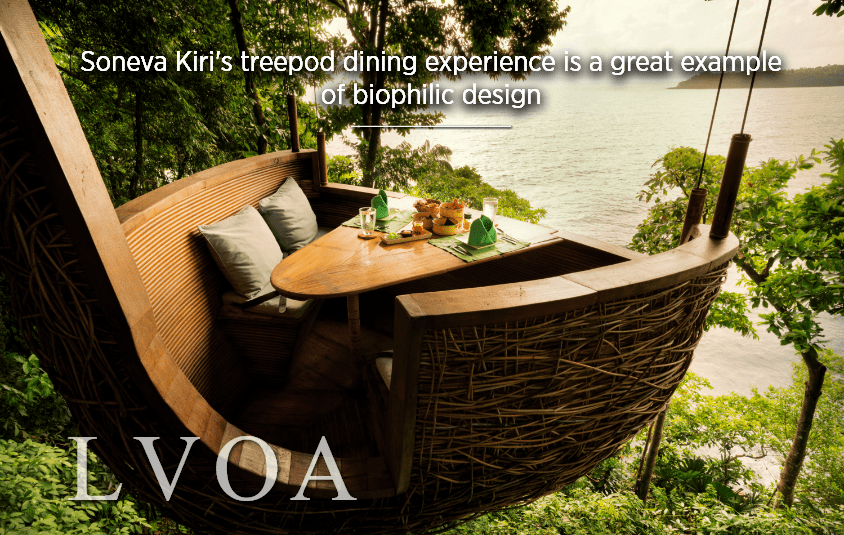Wellness is now one of the biggest and fastest growing sub-sectors of the hospitality industry. Even before Covid-19, the wellness industry was valued at an estimated USD4.5 trillion, and since 2020, people are more mindful of caring for themselves in ways perhaps taken for granted in the past. These days, guests are looking to prioritise physical and mental health, as well as innovative and interesting ways in which they can improve their health on holiday.
As hotel stays provide escape and relaxation, the rest of body and mind, it makes sense that health and wellbeing is now a priority when it comes to hotel architecture and interior design. So, how exactly can design promote the health and wellbeing of guests?
Lobby
The traditional hotel lobby, with its reception desk, high ceilings and grand staircase, is being phased out in favor of more aesthetically pleasing spaces and tranquil settings. These set the tone for the overall hotel experience and often also represent the locale of the hotel. Beyond the importance of first impressions, lobby spaces are now expected to be multi-functional, with the inclusion of cafes or bars right at the hotel’s entrance, presenting new revenue opportunities.
Guests, particularly Millennial guests, now spend less time in their rooms and more time exploring the hotel. The word “spend” is emphasised here, as this exploration often includes making additional purchases at hotel cafes, restaurants, bars, spas, or elsewhere. Hotel design should reflect this demand and hotels can capitalise on the trend by offering a diversity of places for guests to enjoy.
Think of the open-plan Lobby Lounge at Bangkok’s Sindhorn Kempinski. This space ticks off a number of current trends, including bringing the outside in through floor-to-ceiling windows, abundant natural light, an inviting social lounge that attracts locals as well as guests (afternoon tea in the day, then cocktails by evening), as well as seamless hybrid spaces for check-in and F&B. The nod to the locale couldn’t be more perfect, as the leafy decor emulates the oasis of Lumpini Park, the setting for this five-star property.
Sensory experiences
Lighting is having a lightbulb moment when it comes to hotel design. Having spent much of the past two years isolated indoors, people are more aware than ever of the power of sunlight, which provides much-needed Vitamin D and helps regulate circadian rhythms.
The regulation provided by natural light can combat issues such as jet lag and insomnia – with the latter becoming an epidemic within the pandemic. Sleep is a major trend in the hospitality industry right now. Our internal, light-timed circadian rhythms control mood, immunity and metabolism, among other internal systems, making this design element key when it comes to wellbeing.
However, sight is not the only sense being considered. For a truly holistic wellness concept, hotels are ticking off all the senses.
Sound baths have become an on-trend fixture when it comes to wellness treatments, the quality of bedding – particularly the use of natural fibers – are paramount, while aromatherapy addresses the sense of smell and increasingly health- and environmentally-conscious F&B concepts tackle the sense of taste.
Communal spaces
When you think of wellness-inspired design, you may think empty, minimalist decor and hushed voices. However, socialisation is also key to creating a positive atmosphere. Hybrid spaces were already on-trend pre-pandemic, and as Covid-19 has blurred the lines between work and home, hotels are being reinterpreted into flexible spaces where people can relax, work, and also meet like-minded individuals.
Loneliness is another global epidemic in itself, exacerbated by the isolation of the pandemic and the rise of technology replacing in-person interactions. Wellness travel is also about bringing people together through activities and workshops. For example, farm-to-table cooking classes allow guests to mingle, but also connect guests to the local community via suppliers and homegrown produce.
Capella’s new sister brand, Patina, is the embodiment of this newfound community demand, conceptualised around the growing digital nomad trend: “Transitions between work, play, exercise, and wellbeing are seamless. Sanctuary and stimulation live in harmony.”
In contrast to the privacy and exclusivity afforded by Capella properties, the new Patina Maldives, Fari Island, provides limitless opportunities for connectivity with both the environment and other guests. There’s a permaculture garden where guests are encouraged to forage, participative workshops such as group drumming sessions, and even a 3D printing lab where kids can learn about repurposing plastic waste from the ocean, which echoes the eco-minded techniques used to construct the resort’s villas.

Biophilic design
Other lines being blurred are those between inside and outside; bringing the outdoors in, opening spaces out into nature and injecting greenery into hotel design that emulates values relating to sustainability. Interface and Terrapin Bright Green’s 2017 Human Spaces Report revealed that guests spend 36% more time in hotel lobbies with biophilic design elements than traditional lobby spaces.
Soneva is a wellness-minded brand that does biophilic design very well. Soneva Kiri on Thailand’s Koh Kood is an eco-friendly resort set in tropical rainforest, and certainly takes its lead from the environment. The resort’s bamboo dining pods are hoisted up to the treetops and waiters bring over food and drink via zipline.
Wellness-inspired design
Infusing wellness into hotel concepts is a great way to create an overall holistic experience for guests. No longer is health and wellbeing an experience confined to the hotel spa, but a core value considered throughout every aspect of hotel design.







